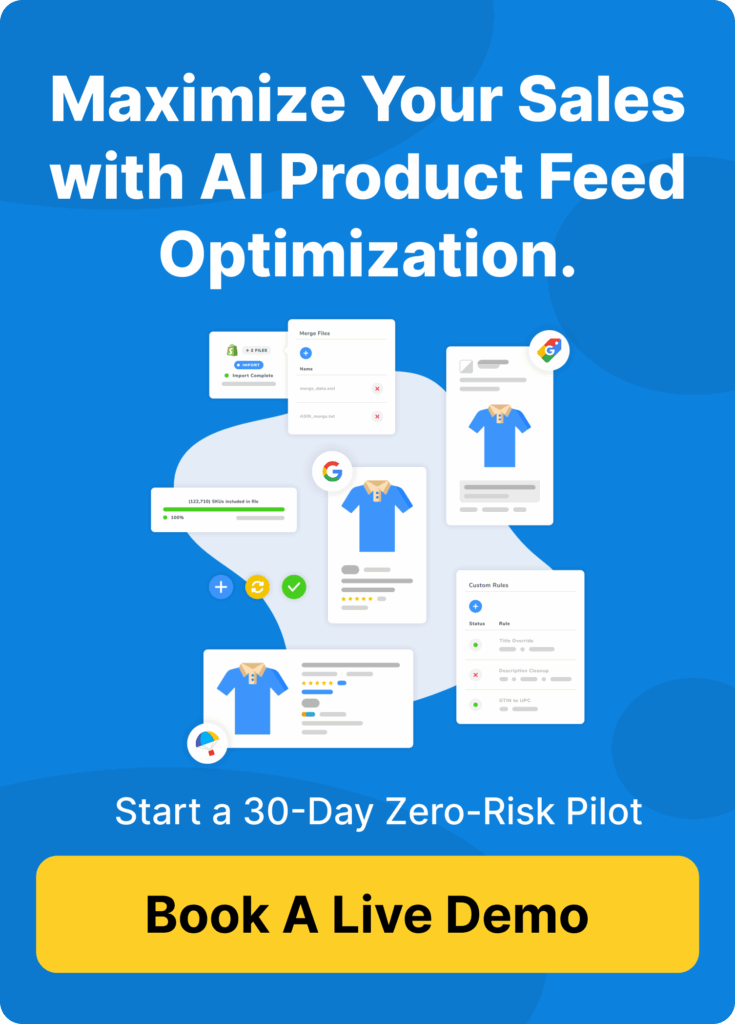Beginning your journey with FeedOps, a platform designed to empower digital marketers to master product feed optimization, is an exciting step forward. While FeedOps is designed to be user-friendly, depending on your level of expertise and familiarity with feed optimization, you might appreciate a little guidance. That’s where this guide comes in.
Whether you’re a novice or a seasoned pro, our aim is to ensure you feel comfortable and confident while using FeedOps. So, let’s dive in:
Contents
Step 1: Connect Your Store to FeedOps
The first step is connecting your e-commerce platform to FeedOps via our API. Based on our experience, around 90% of users need assistance during this initial stage – and that’s perfectly okay. We encourage you to book a meeting with us, and we’ll walk you through this process, ensuring a smooth start on your journey.
Step 2: Review Your Initial Product Data Audit
If you are amongst the 10% that have made it this far, congratulations! The next step is to review the first product data audit that FeedOps produces. This happens automatically when you connect and by default, these audits will occur monthly. The audits serve as a way to highlight areas in your product feed that can be improved. You can share the audit with a developer, agency, or if you’re an agency, with your client. Over time, this audit trail can be particularly useful when comparing the difference between two points in time if you’re trying to troubleshoot a sudden drop or gain in traffic or sales.
Step 3: Follow the AI-Driven Playbook
Guided by the insights from your initial audit, our AI-driven playbook provides personalized advice for your specific product feed. This playbook, which refreshes every time you log in, gives you both a health and optimization score. The health score highlights any systemic issues that may stop products from showing or being approved. The optimization score is channel-specific (e.g., Google, Microsoft, Meta) and suggests what you need to fix first to improve the score. The higher the score, the better your chances of getting your products seen by potential customers.
Step 4: Fix Missing or Incomplete Attributes
The audit may highlight missing or incomplete attributes in your product feed. These systemic data attribute issues can affect the reach and effectiveness of your advertising because the data you provide to advertising platforms like Google, Microsoft, and Meta is all they know about the products you sell. You can fix product attributes in a few ways in FeedOps:
a) By mapping a field in your database to a field in FeedOps
b) Requiring them in the categories or attribute section
c) Accepting the FeedOps AI suggestions
Remember, product feed optimization is a process. Investing some initial effort in the beginning can pay dividends down the road. If you think you need help with this, don’t hesitate to book a meeting with us or send us a message.
Step 5: Expand Your Product Type Depth
Product Types are the equivalent of how you categorize your website. This is distinct from Google Product Categories, which is how Google, Microsoft, and Meta map your products to their taxonomies to drive Shopping and Shops. Yes, Microsoft and Meta specifically use Google Product Categories. Ensuring that your product types follow a logical structure and include common keywords will greatly assist the ad platforms’ AI in better positioning your products in front of the people most likely to buy. Aim for 3 to 5 levels of Product Type categorisation.
Step 6: Incorporate Popular Search Terms
This is where the rubber hits the road in Google Pmax with Shopping and Bing Shopping. Incorporating popular search terms in your product types, titles, and descriptions can not only elevate your products in organic shopping results but also improve their placements in your paid shopping ads. This is an advanced tactic, but you can use the same keywords in multiple products to increase click share (where your products appear more than once in the search results). This strategy can enhance the visibility and competitiveness of your products.
Embarking on the path of mastering product feed optimization with FeedOps is an exciting journey. Remember, we’re here to help every step of the way. Don’t hesitate to reach out if you need assistance, and stay tuned for our next blog post where we’ll tackle overcoming common roadblocks in product feed optimization.



